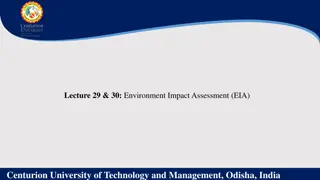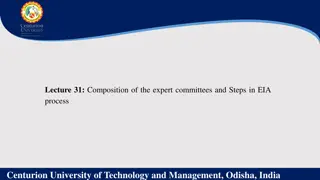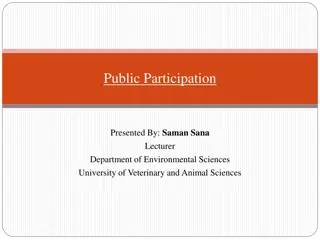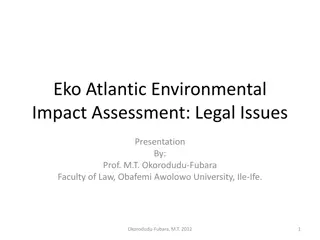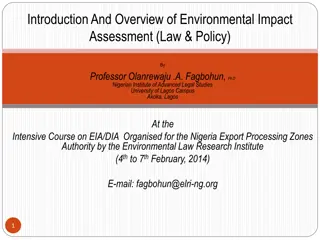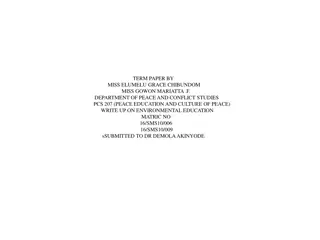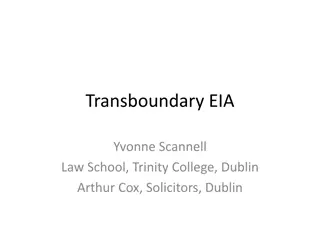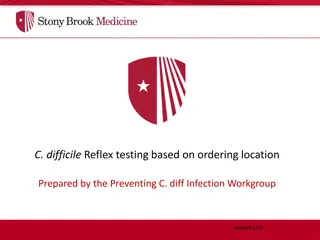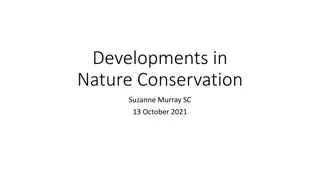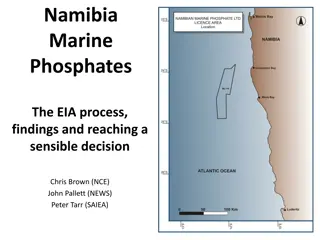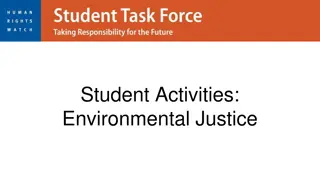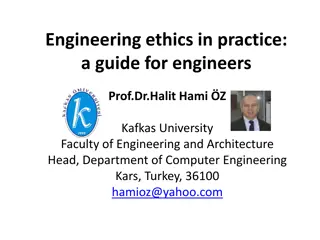Evolution of Environmental Impact Assessment (EIA) and its Significance
EIA began in response to environmental crises in the 1960s due to population growth, industrialization, and urbanization. Developing countries also face severe environmental challenges, necessitating EIA adoption. The history and reasons for EIA implementation are outlined, emphasizing the global importance of environmental assessment.
- EIA Evolution
- Environmental Impact Assessment
- Environmental Crisis
- Developing Countries
- Population Growth
Download Presentation

Please find below an Image/Link to download the presentation.
The content on the website is provided AS IS for your information and personal use only. It may not be sold, licensed, or shared on other websites without obtaining consent from the author. Download presentation by click this link. If you encounter any issues during the download, it is possible that the publisher has removed the file from their server.
E N D
Presentation Transcript
GENERAL INTRODUCTION AND HISTORY OF EIA
Basic knowledge of participants about EIA
Why did EIA start? By the early 1960s in the US and other industrial countries, it was clear that something was wrong Silent Spring by Richeal Carison
Cuyahoga River burns in 1966 (3rd time). Cleveland, Ohio, U.S. 30 Years of Environmental Progress, USEPA, 2000.
Environmental crisis in the industrial economies 1952 killer fog kills 4,000 in London 1963 Rachel Carson s Silent Spring documents the negative effects of DDT 1966 Cayahoga River in Ohio catches fire
What was happening? Looking back from today, the causes were obvious: Population Growth Natural Resource Pressures Urbanization Industrialization Unrestrained profit motive These forces were all combining to create unprecedented environmental damage
Why should developing countries care about EIA? Easy answer: Donor requirements. In the early 1970s, several Pakistani workers died as a result of negligent pesticide management procedures on a USAID project. USAID was sued by an environmental PVO, and adopted environmental review procedures to comply with NEPA ( Reg 216 ) Almost all donor agencies now have similar procedures
The difficult answer: Because the environmental crisis faced by most developing countries is at least as serious as that of the industrialized countries in the 1960s and 70s. Lower levels of industrialization BUT. . . High population growth and urbanization Use of hazardous substances Environmental degradation due to poverty
Chemical pollution: obsolete pesticides in Mozambique. U.N. Food and Agriculture Organization
Deforestation: trees cleared for planting in Guinea. U.N. Food and Agriculture Organization
Environmental crisis in the developing world 1984 Methyl isocyanate cloud from Union Carbide plant accident in Bhopal, India kills 2,000+ Cities with worst air quality: Developing country megacities Millions of deaths/year from environmental conditions particularly poor sanitation 1984 Methyl isocyanate cloud from Union Carbide plant accident in Bhopal, India kills 2,000+ Cities with worst air quality: Developing country megacities Millions of deaths/year from environmental conditions particularly poor sanitation
Regions Africa Major Environmental Issues The continent has the world s poorest and most resource dependent population. It carries the highest health burden due to severe environmental problems. These include desertification and soil degradation, declining food security, and increasing water scarcity. Rapid economic growth, urbanization and industrialization have helped in poverty alleviation but also increased pressure on land and water resources, widespread environmental degradation and high pollution levels. Mega- cities are a particular focus of environmental and health concerns. Despite progress with economic restructuring and environmental clean up, there is a legacy of industrial pollution and contaminated land during communist era. In many areas, emissions of particulates, SO2, lead, heavy metals and toxic chemicals continue to expose the residents to health risks. Asia and Pacific Eastern Europe and Central Asia Latin America and the Caribbean Approximately three-quarters of the population live in urban areas. Many cities are poor, overcrowded, polluted and lack basic infrastructure. The major environmental issue is the destruction of tropical forests and consequent loss of biodiversity, which is especially serious in the Amazon basin.
The National Environmental Policy Act 1969 of USA is the legislative basis for EIA. The policy was the result of wide spread recognition in the 1960s that some major environmental problems were created by the government s projects (power stations, dams and reservoirs, industrial complexes). UNECE - Convention on EIA in a Trans-boundary Context (1991) Entered into force in 1997 as the first EIA-specific international treaty.
Four cornerstones of the Earth Summit The Rio Declaration on Environment and Development- a set of principles which provides guidance on achieving sustainable development. Framework Convention on Climate Change- an international treaty to stabilize greenhouse gas concentration in the atmosphere. Convention on Biological Diversity- an international convention with three objectives: the conservation of biodiversity, the sustainable use of its components, and the equitable sharing of benefits from genetic resources. Agenda 21- a global programme of action for achieving sustainable development to which countries are politicallycommitted rather than legally obliged. 16
Definition of EIA Environmental Impact Assessment is EIA is a systematic process to identify, predict and evaluate the environmental effects of proposed actions and projects. Environment is broadly interpreted: physical, biological, and social.
E I A It is a planning and management tool for sustainable development that seeks to identify the type, probability of environmental and social changes likely to occur as direct or indirect result of a project or policy and to design the possible mitigation procedure. magnitude and In EIA, the term impacts is used instead of effects of activities. What is an impact?
What is an impact? The impact of an activity is a deviation (a change) from the baseline situation that is caused by the activity. The baseline situation is the existing environmental situation or condition in the absence of the activity. ! To measure an impact, you must know what the baseline situation is. The baseline situation is a key concept in EIA. More
The baseline situation Water Quantity, quality, reliability, accessibility In characterizing the baseline situation, many environmental components MAY be of interest Soils Erosion, crop productivity, fallow periods, salinity, nutrient concentrations Fauna Populations, habitat The components of interest are those that are likely to be affected by your activity or upon which your activity depends for its success Env Health Disease vectors, pathogens Flora Composition and density of natural vegetation, productivity, key species Key species Special ecosystems
The baseline situation The baseline situation is not simply a snapshot. Water table Describing the baseline situation requires describing both the normal variability in environmental components & current trends in these time components. This chart of groundwater levels shows both variability and a trend over time. Both are part of the groundwater baseline situation.
Types of impacts & their attributes Direct & indirect impacts The EIA process is concerned with all types of impacts and may describe them in a number of ways Short-term & long- term impacts Adverse & beneficial impacts Cumulative impacts Intensity Direction Spatial extent Duration Frequency Reversibility Probability But all impacts are NOT treated equally.
Specifically, !It is ESSENTIAL in EIA to focus on the most significant impacts. Don t waste effort & time analyzing and discussing impacts that are less important.
EIA Core Values A number of core values and guiding principles for the practice of EIA have been identified: Sustainability EIA process result in environmental safeguards as it is anticipatory and preventive rather than curative (aids precautionary and preventive principle). Integrity the process will conform to agreed standards and be performed by multidisciplinary teams. Utility the process provides balanced, credible information for decision- making. 25
Key Guiding Principles for EIA Continuity - as an integral part of planning, designing and implementation cycle of and development initiative, EIA should run continuously and throughout project cycle. Participatory - EIA provides a framework for stakeholders and all interested parties to participate in decision-making. Transparency EIA facilitates dialogue, predictions and responses in a forum where proponents, decision-makers, experts and the public interact in an open and accessible way in considering the potential impacts of a project on local community, natural resources and environmental quality. All assessment decisions and their basis, should be open and accessible. Credibility assessments are undertaken with professionalism and objectivity, using multidisciplinary skills. Certainty the process and timing of assessment must be agreed in advance and followed by all participants. 26
Cost-effectiveness the assessment process and its outcomes will ensure environmental protection at the least cost to society. It ensures fair and equitable distribution of project costs and benefit. As a minimum, local people in a project area must not be worse-off than they were before a project was implemented. Flexibility the assessment should be able to adapt to deal efficiently and effectively with any proposal or decision- making situation. Practicality the information and outputs are readily usable for planning, designing and in decision-making. Accountability decision-makers are responsible to all parties for decision and actions under the assessment process. 27
What is an activity? We are discussing the impacts of activities. What are activities? An activity is: a desired accomplishment or output Accomplishing an activity requires a set of actions E.g.: a road, seedling production, or river diversion to irrigate land ACTIVITY: market access road rehabilitation ACTIONS: Survey, grading, culvert construction, compaction, etc. . . A project or program may consist of many activities
The EIA process Phase II: Full EIA study (if needed) Phase I: Initial inquiries Scope Evaluate baseline situation Identify & choose alternatives Identify and characterize potential impacts of proposed activity and each alternative Develop mitigation and monitoring Communicate and document Understand proposed activities Screen Conduct preliminary assessment (if needed) Our focus!
Phase 1 of the EIA Process Phase I Phase II Understand proposed activity Screen the activity Conduct a Preliminary Assessment BEGIN FULL EIA STUDY Based on the nature of the activity what level of environmental review is indicated? SIGNIFICANT ADVERSE IMPACTS POSSIBLE ACTIVITY IS OF MODERATE OR UNKNOWN RISK Why is the activity being proposed? A rapid, simplified EIA study using simple tools SIGNIFICANT ADVERSE IMPACTS VERY UNLIKELY What is being proposed? ACTIVITY IS LOW RISK (Of its nature, very unlikely to have significant adverse impacts) STOP the EIA process ACTIVITY IS HIGH RISK(Of its nature, likely to have significant adverse impacts)
Phase 1 of the EIA process: Understand the proposed activity Understand the proposed activities ALL EIA processes begin with understanding WHAT is being proposed, and WHY. The question WHY IS THE ACTIVITY BEING PROPOSED? Is answered with the development objective (D.O.). Why is the activity being proposed? What is being proposed? building a road Not a D.O.! increasing access to markets Is a D.O. We must understand the Development Objective to identify environmentally sound alternatives
Phase 1 of the EIA process: Understand the proposed activity Once we understand the development objective, we must fully understand WHAT is being proposed. Understand the proposed activities Why is the activity being proposed? This includes associated actions! PRIMARY ACTIVITY: construction of diversion dam & irrigation canal What is being proposed? ASSOCIATED ACTIONS: Survey negotiate land tenure construct borrow pit establish construction camp construct temporary diversion structure dispose of soil, debris
Phase 1 of the EIA process: Screen the activity Screen each activity SCREENING is the process of asking a very basic set of questions about the nature of activity. These questions: do NOT require analysis. do NOT require detailed knowledge about the proposed sites, techniques or methods Example screening questions: Does the activity involve: Penetration road building? Large-scale irrigation? Introduction of non-native crop or agroforestry species? Based on the nature of the activity, what level of environmental analysis is indicated?
Phase 1 of the EIA process: Screen the activity Screen each activity screening classifies the activity into a RISK CATEGORY: Based on the nature of the activity, what level of environmental analysis is indicated? VERY LOW RISK EIA process ends Do full EIA study VERY HIGH RISK MODERATE OR UNKNOWN RISK Do preliminary assessment The outcome of the screening process determines the next step in the EIA process
Phase 1 of the EIA process: Screen the activity ! Each donor agency and national EIA law has its own set of screening questions. Screening is the topic of an upcoming module
Phase 1 of the EIA process: The Preliminary Assessment Conduct a Preliminary Assessment The purpose of a preliminary assessment is to provide documentation and analysis that: Allows the preparer to determine whether or not significant adverse impacts are likely Allows the reviewer to agree or disagree with the preparer s determinations Sets out mitigation and monitoring for adverse impacts A rapid, simplified EIA study using simple tools ! Screening determines whether the preliminary assessment is necessary
Phase 1 of the EIA process: The Preliminary Assessment Typical Preliminary Assessment outline For each activity it covers, a preliminary assessment has 3 possible findings: The project is very unlikely to have significant adverse impacts. (EIA process ends) With specified mitigation and monitoring, the project is unlikely to have significant adverse impacts The project is likely to have significant adverse impacts (full EIA study is required) 1. Background (Development objective, list of activities) 2. Description of the baseline situation 3. Evaluation of potential environmental impacts 4. Mitigation & monitoring 5. Recommended Findings
What is mitigation? Mitigation is. . . The implementation of measures designed to reduce the undesirable effects of a proposed action on the environment Mitigation is the topic of an upcoming module!
To arrive at findings: Identify, Predict and Judge Arriving at the FINDINGS in a preliminary assessment requires 3 steps: 1 Many resources describe the potential impacts of typical small-scale activities. Identify potential impacts 2 Determine which potential impacts are likely to become actual, and quantify these impacts to the extent possible. Predict potential impacts 3 Judge the significance of potential impacts Determine whether the predicted impacts are indeed significant! THIS WILL OFTEN DEPEND ON HOW EFFECTIVE THE PROPOSED MITIGATION MEASURES ARE!
Subsequent modules. . . Present tools to assist in identifying & predicting impacts Discuss the factors involved in judging significance
! We only proceed to Phase II of the EIA process if Phase I indicates that a FULL EIA STUDY is required Most small-scale activities do not require a full EIA study!
Phase 2 of the EIA process: The Full EIA study ! A formal scoping process precedes the study to ID issues to be addressed The full EIA study has very similar objectives and structure to a preliminary assessment. Analysis of environmental impacts is much more detailed ! Alternatives* must be formally defined. The impacts of each alternative must be identified & evaluated, and the results compared. ! However, the full EIA study differs in important ways: Public participation is usually required. ! *includes the project as proposed, the no-action alternative at least one other real alternative A professional EIA team is usually required.
Phase 2 of the EIA process: The Full EIA study Basic steps of the full EIA study With a few additions, the basic outline of the preliminary assessment is the template for the steps involved in a full EIA study: Scope Communicate & Document throughout Evaluate baseline situation Identify & choose alternatives 1. Background (Development objective, list of activities) Identify and characterize potential impacts of proposed activity and each alternative 2. Description of the baseline situation 3. Evaluation of potential environmental impacts Compare alternatives 4.Mitigation & monitoring Develop mitigation and monitoring 5.Recommended Findings
Phase 2 of the EIA process: The Full EIA study In summary, The full EIA study is a far more significant effort than the preliminary assessment. It is reserved for activities for which screening or the preliminary assessment shows that significant impacts are likely.
Who is involved in EIA? Public consultation is usually only REQUIRED for full EIA studies. Sponsor of the activity (usually commissions/conducts the EIA) Regulatory agencies/ Review authorities Broad-based public Communities (men & women) Civil society Private Sector However, it is good practice for preliminary assessments because: Predicting impacts is FACILITATED by broad- based public consultation; Judging significance is very difficult without it. Transparency and accessibility require disclosure to stakeholders
Making EIA effective To be an effective tool for SD, EIA must be: a integral part of the project development cycle. EIA is undertaken early enough to affect project design Mitigation and monitoring developed in the EIA process is implemented. The full EIA study must consider real alternatives Honest Impacts must be assessed honestly. Transparent & accessible The EIA products must be clear and accessible to key actors.
Costs and Benefits of Using EIA Benefits There are both direct and indirect benefits of EIA. More environmentally sustainable design or improvements in the design. Better compliance with environmental standards. Savings in capital and operating cost. Reduces time and cost of approvals of development application. Resolves conflict, solves problems and thus increase project acceptability. Improves institutional co-ordination and inter-agency co-operation. Improves accountability and transparency in planning and decision-making For business and governments - EIA - important planning and management tool. Environmental assessments good > good management > good business 47
Costs Determination of exact costs of preparing EIA is often difficult. Proponent is usually responsible for carrying out an environmental impact assessment and incurring associated costs. Too late introduction or start of EIA in the project cycle; poor drafting of terms of references; inadequate management of EIA according to schedule; inadequacy of EIA reports and requirement for additional technical data and upgrading, result in prolonged time duration for the administration of EIA process and hence more financial resources. 48
Government planning and decision-making: D-D-D -- Discuss, Decide, Deliver









